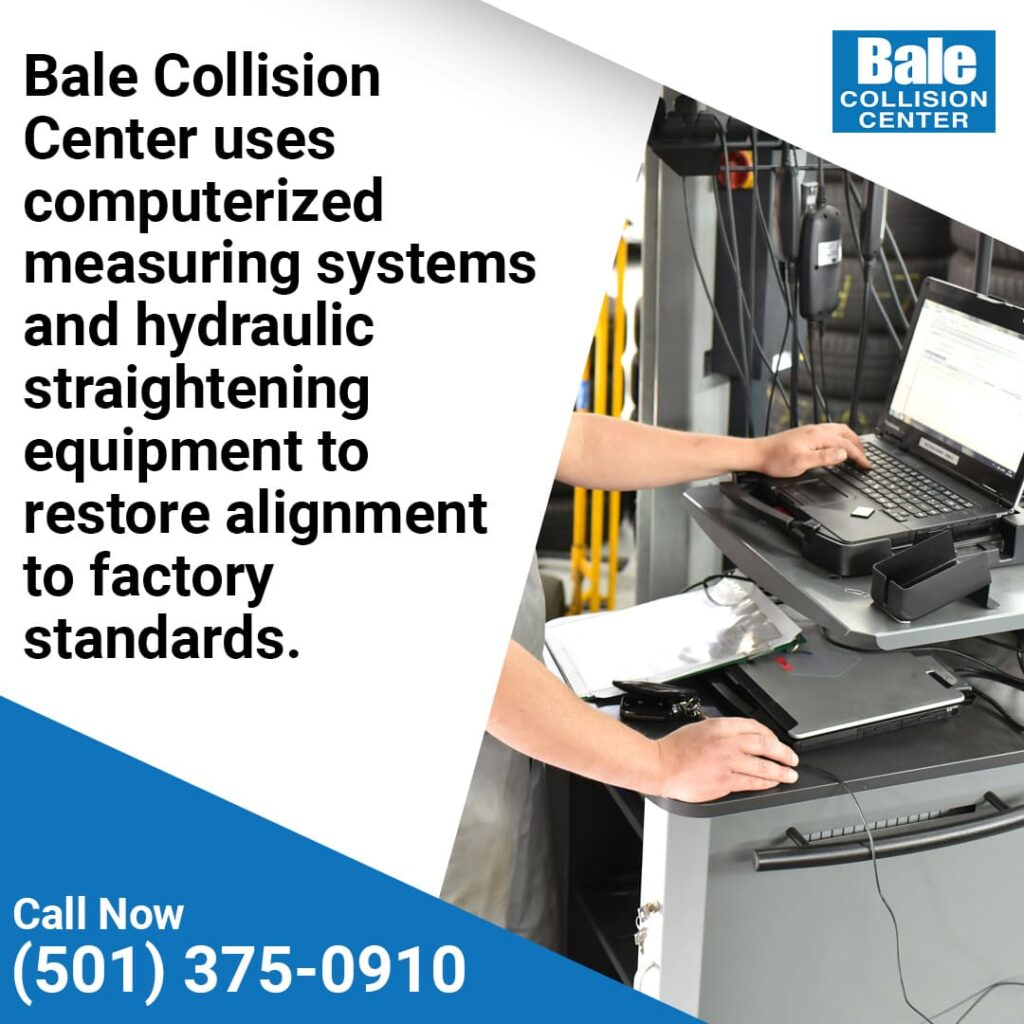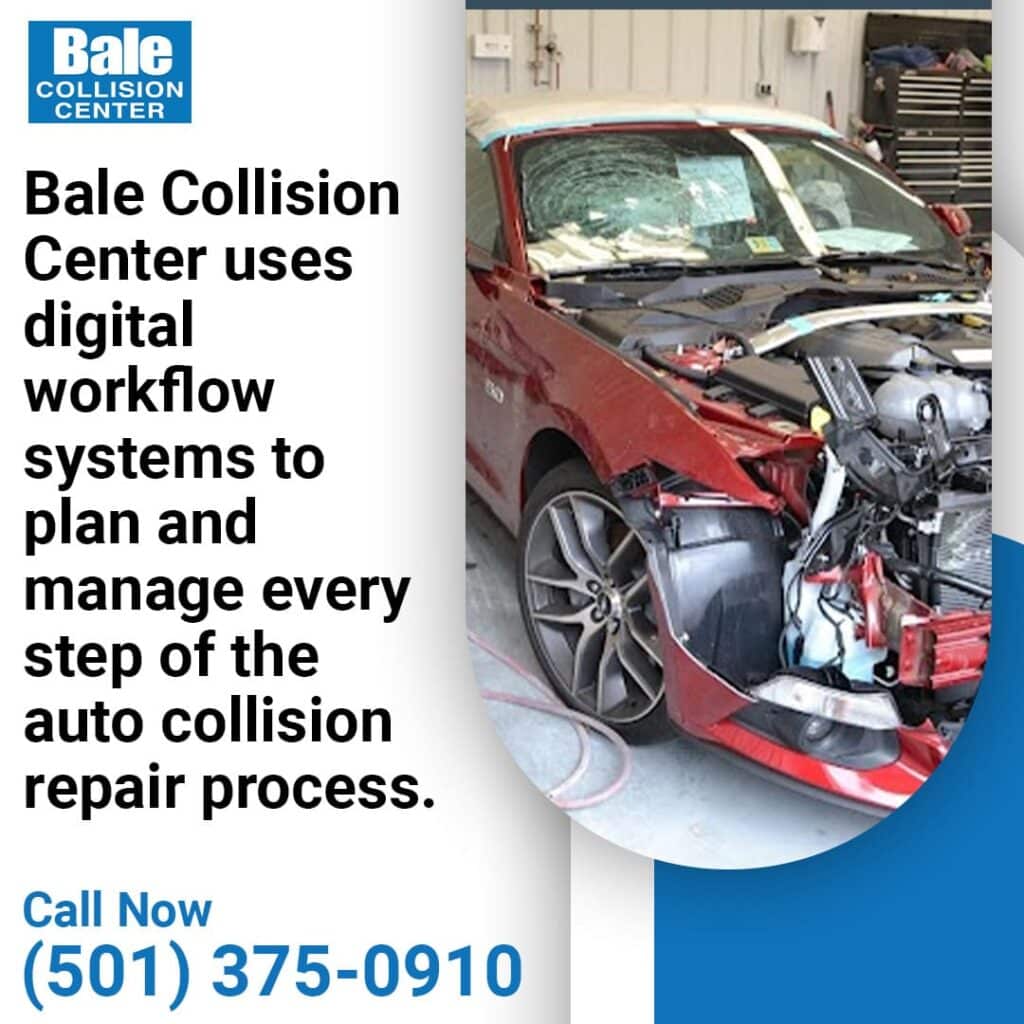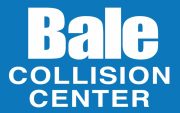New vehicle models include advanced driver systems, sensitive sensors, and lightweight materials. These require more than traditional repair methods. At Bale Collision Center in Little Rock, AR, we use up-to-date technology to meet manufacturer repair standards.
From digital diagnostics to ADAS calibration, every step of the process is guided by precision. Our team is trained to work with OEM procedures and certified equipment, ensuring that each repair meets strict safety and performance standards. This article explains the technologies and practices our auto body collision shop uses to deliver consistent, high-quality results.

The Role of Technology in Modern Collision Auto Repair
Advanced technology helps collision centers diagnose, repair, and verify damage with more accuracy and less guesswork. Modern vehicles rely on electronics and sensors. A 2024 PARTS report notes that several ADAS features, such as forward collision warning and automatic emergency braking, are present in over 90% of 2023 model-year vehicles. These systems require proper calibration after they have been repaired. Bale Collision Center uses OEM-calibrated scan tools to confirm that every sensor functions properly post-repair.
How Vehicle Design Has Changed Over Time
Today’s vehicles use lightweight materials and integrated electronics, which make repairs more complex. Steel frames have been replaced by aluminum, carbon fiber, and plastic composites in many newer models. These materials are strong but behave differently in a collision. Using the wrong repair method can weaken a car’s safety performance.
Electronic systems have also expanded. Vehicles now include cameras, lane sensors, blind-spot monitors, and radar. All of these must be recalibrated to work correctly after a collision. At Bale Collision Center, our technicians are trained in these modern materials and systems. We follow brand-specific procedures to restore both appearance and safety after damage.
Why Traditional Repair Methods No Longer Suffice
Older collision repair tools and techniques don’t account for new materials, sensors, and electronics. Traditional auto body collision shops might rely on visual inspections and manual alignment. That’s not enough when internal systems control critical features like steering and braking.
For instance, radar sensors behind a bumper cover may be misaligned by just a few millimeters and still appear fine to the naked eye. This can prevent ADAS features, such as automatic emergency braking, from working correctly.
At Bale Collision Center, we use digital diagnostics and precise recalibration tools to correct these issues. This avoids future safety problems and gives vehicle owners peace of mind.
Meeting Manufacturer Repair Specifications
Following OEM guidelines helps collision repairs meet the safety and performance standards set by the automaker.
Each vehicle make and model comes with its own auto collision repair process. These can include weld patterns, sensor calibration steps, and structural part replacement. Skipping steps or using generic parts can affect how the vehicle performs in a future crash.
At Bale Collision Center, we use OEM service manuals, factory-approved parts, and updated software tools for collision repairs in Little Rock, AR. Our technicians are I-CAR Platinum-certified, which helps them align every repair with the latest manufacturer guidelines.
Identifying Damage with Digital Diagnostic Tools
Digital diagnostic tools reveal hidden issues that visual inspections often miss. Dozens of sensors connected to electronic control units (ECUs) in modern vehicles may store trouble codes in the system even if there are no visible signs of damage. A post-collision scan can detect errors in systems like airbags, ADAS (Advanced Driver Assistance Systems), and power steering.
At Bale Collision Center, pre- and post-collision repair scans are standard. This allows our technicians to confirm that all systems work as intended before a vehicle is returned to the owner.
The Limits of Visual Inspections
Visual checks alone cannot confirm whether internal vehicle systems are damaged or out of sync. A vehicle might look fine after a minor crash, but hidden damage could affect safety systems. For example, a front bumper may appear undamaged while the forward radar sensor behind it has shifted slightly, making features like adaptive cruise control unreliable.
This is why our collision center in Little Rock, AR, uses digital scanning tools to verify all active and passive safety systems. Visual inspection is still part of the process, but it is now just one step among many.
Electronic Control Units (ECUs) and System Scans
System scans identify fault codes stored in ECUs that would otherwise go unnoticed. Modern vehicles can have up to 150 ECUs. Each controls a specific function—from airbag deployment to lane assist. After a collision, even minor impact forces can trigger fault codes in these modules, especially in vehicles equipped with ADAS.
At Bale Collision Center, we use OEM-compliant scan tools to read these codes before and after every collision repair. This confirms that all systems are functioning correctly. The shop also documents scan results for insurance partners and customers. Our auto body collision shop uses digital diagnostics in combination with technician skills to deliver accurate repairs and restore vehicle performance.
What It Means to Follow OEM Repair Procedures
Following OEM procedures means repairs are completed using methods approved by the vehicle’s manufacturer. At Bale Collision Center, we follow official OEM repair procedures. These guidelines detail how specific makes and models should be repaired after a collision to maintain their original performance and safety standards.
OEM repair procedures include instructions on welding, part replacement, structural measurements, and system calibrations. Technicians at our collision repair center in Little Rock, AR, use these procedures for every applicable repair. By following these steps, we restore vehicles using the same specifications the automaker used during manufacturing.
Why I-CAR Certifications Matter
I-CAR Gold Class certification shows that a shop meets high training and repair standards set by the collision industry. Bale Collision Center holds I-CAR Gold Class status. This means our shop trains technicians continuously on the latest repair techniques, tools, and vehicle technologies.
In addition, our technicians are I-CAR Platinum certified, which reflects advanced expertise in structural, non-structural, and mechanical repairs. These credentials demonstrate a consistent investment in technician education and repair accuracy.
Why Equipment Matters for Structural Repairs
Proper tools support accurate repairs when working on a vehicle’s frame or structural components. Structural repairs must be completed with millimeter-level accuracy. A small misalignment can interfere with how crash energy is absorbed or how airbags deploy.
At Bale Collision Center, we use computerized Car-O-Liner frame measuring systems and hydraulic straightening benches to restore factory alignment. These systems also create digital reports for insurance documentation. Using advanced equipment confirms that structural components meet the alignment required for vehicle safety systems to work correctly.
Matching Manufacturer Tolerances
Repairing to the manufacturer’s tolerances reduces the risk of future part failure or system malfunction. Tolerances are the narrow limits allowed for part alignment, bolt torque, and system calibration. In modern vehicles, especially those equipped with ADAS or aluminum frames, these tolerances are extremely strict. At Bale Collision Center, our collision repair technicians use calibrated tools to stay within the manufacturer’s specifications.
ADAS Calibration After a Collision
ADAS calibration is essential for your vehicle’s safety systems to work as intended after a collision.
What is ADAS (Advanced Driver Assistance Systems)?
ADAS refers to electronic systems that enhance the safety of your vehicle by supporting functions like automatic braking, lane-keeping, and collision warnings. Examples of ADAS features include Adaptive Cruise Control, Blind Spot Monitoring, and Lane Departure Warning.
When a vehicle is involved in a collision, even minor impacts can shift or misalign the sensors and cameras used to collect data from the vehicle’s surroundings. This misalignment affects the accuracy of ADAS features, making it important for shops like Bale Collision Center to recalibrate them post-repair.
How Sensor Misalignment Affects Safety
Sensor misalignment can lead to critical failures in safety systems, making them unreliable in emergencies. Sensors that power ADAS are often placed on the front and rear bumpers, the windshield, or within the vehicle’s structure. If the sensors shift due to collisions, it can prevent them from properly detecting objects or changes in the vehicle’s environment.
Tools Used for Recalibration at Bale Collision Center
At Bale Collision Center, we use advanced tools for ADAS recalibration. After an auto collision repair, recalibrating ADAS systems requires specialized equipment to realign sensors and cameras. Our collision center in Little Rock, AR, uses the latest calibration tools, such as target-based systems, dynamic calibration systems, and diagnostic scanners. These recalibration tools keep your ADAS systems reactivated and fully operational.
Streamlining Repairs Through Digital Workflow Systems
Digital workflow systems improve the efficiency and accuracy of the collision repair process. At Bale Collision Center, digital workflows are integral to streamlining repairs, improving turnaround times, and enhancing communication between technicians, customers, and insurance providers.
How Digital Repair Plans Improve Turnaround Times
Digital repair plans speed up the repair process by organizing tasks and resources more efficiently. Instead of relying on manual processes and paper-based records, Bale Collision Center uses digital repair management software to create detailed, step-by-step repair plans. This digital approach enables us to quickly identify parts needed, ensure accurate labor tracking, and increase productivity.
Updates for Customers
Updates give customers greater visibility into the repair process, improving communication and reducing uncertainty. At Bale Collision Center, customers receive updates on their vehicle’s repair status through our digital systems twice a week. We provide notifications when key steps are completed, such as when parts are received or when repairs begin.
Communication Between Repair Shop and Insurance Providers
Digital systems enable seamless communication between our shop and insurance providers, ensuring efficient claims processing and repair authorization. When vehicles are brought in for collision repairs in Little Rock, AR, we use digital systems to instantly share the necessary repair details with insurance providers. This includes estimates, parts needed, and labor hours. By connecting directly with insurance adjusters through our digital platforms, we make sure that approvals and paperwork are handled quickly.
Training Technicians for New Repair Standards
Ongoing technician training is essential to maintain the high standards required in modern collision repair. At Bale Collision Center, we prioritize continuous education for our technicians to make sure they are well-versed in the latest repair techniques, tools, and technologies.
Why Continued Education Matters
Continued education ensures that our technicians are up-to-date on the latest industry practices and repair technologies. Auto collision repair standards are constantly evolving, driven by advancements in vehicle design and repair technology. These advancements require specialized training to repair safely and effectively.
Regular training programs help our technicians stay on top of industry changes, enabling them to handle the most current repair challenges. Our auto body collision shop holds I-CAR and ASE certifications, which demonstrate our commitment to providing top-quality collision repairs in Little Rock, AR.
Working on Hybrid, Electric, and Aluminum-Bodied Vehicles
Specialized training is required when working on hybrid, electric, and aluminum-bodied vehicles. As the automotive market shifts towards hybrid and electric vehicles (EVs), repair methods and safety protocols have evolved. These vehicles often have unique features, such as high-voltage systems or specialized aluminum frames, requiring specialized knowledge and training. Training for hybrid, electric, and aluminum vehicles helps us meet the unique needs of these cars, offering repairs that meet or exceed manufacturer specifications while maintaining vehicle safety.

Bale Collision Center’s Commitment to Precision Repairs
At Bale Collision Center, we are committed to providing precise and reliable collision repairs in Little Rock, AR, that meet manufacturer specifications and customer expectations.
Investing in Tools That Meet Current and Future Needs
Investing in the right tools and technology is vital for staying ahead of repair demands. We regularly update our equipment to stay aligned with current trends in the automotive industry, such as advancements in vehicle technology and new repair materials. This allows us to perform auto collision repairs with the latest diagnostic tools and specialized machinery. Our investment in these tools not only meets the needs of today’s repairs but also prepares us for future challenges in the industry.
Prioritizing Safety, Accuracy, and Accountability
Safety, accuracy, and accountability are core values at our collision center in Little Rock, AR, ensuring every repair meets the highest standards. Our technicians follow strict guidelines to make sure that all repairs are performed with the utmost accuracy. Whether it’s realigning a vehicle’s frame, recalibrating sensors, or replacing airbags, we adhere to manufacturer repair specifications. By focusing on safety and precision, we give customers confidence that their vehicles are in capable hands.
Feedback from Customers in Little Rock, AR
Customer satisfaction is at the heart of our services, and feedback helps us continue to improve. Our customers in Little Rock, AR, consistently praise the precision and quality of our collision repairs. Many clients highlight our timely service, transparent communication, and attention to detail. As an established auto body shop, we aim to provide a customer experience that exceeds expectations.
Connect with Bale Collision Center
At Bale Collision Center, we understand that precision, safety, and efficiency are critical when it comes to collision repair. From investing in the latest tools and technology to ensuring our technicians are highly trained in current repair standards, we are committed to providing exceptional service that meets the highest quality and safety standards. Whether you’re dealing with traditional repairs, advanced driver assistance system (ADAS) recalibrations, or the complexities of modern vehicle designs, our team is equipped to handle it all. Our dedication to customer satisfaction, coupled with transparent communication and reliable results, has made us a trusted collision center in Little Rock, AR.
Need expert collision repair services? Trust Bale Collision Center for accurate, dependable repairs. Call (501) 375-0910 or email bccdowntown@baleautomotive.com to schedule your repair or ask about our services. We’re ready to help you get back on the road with confidence.
